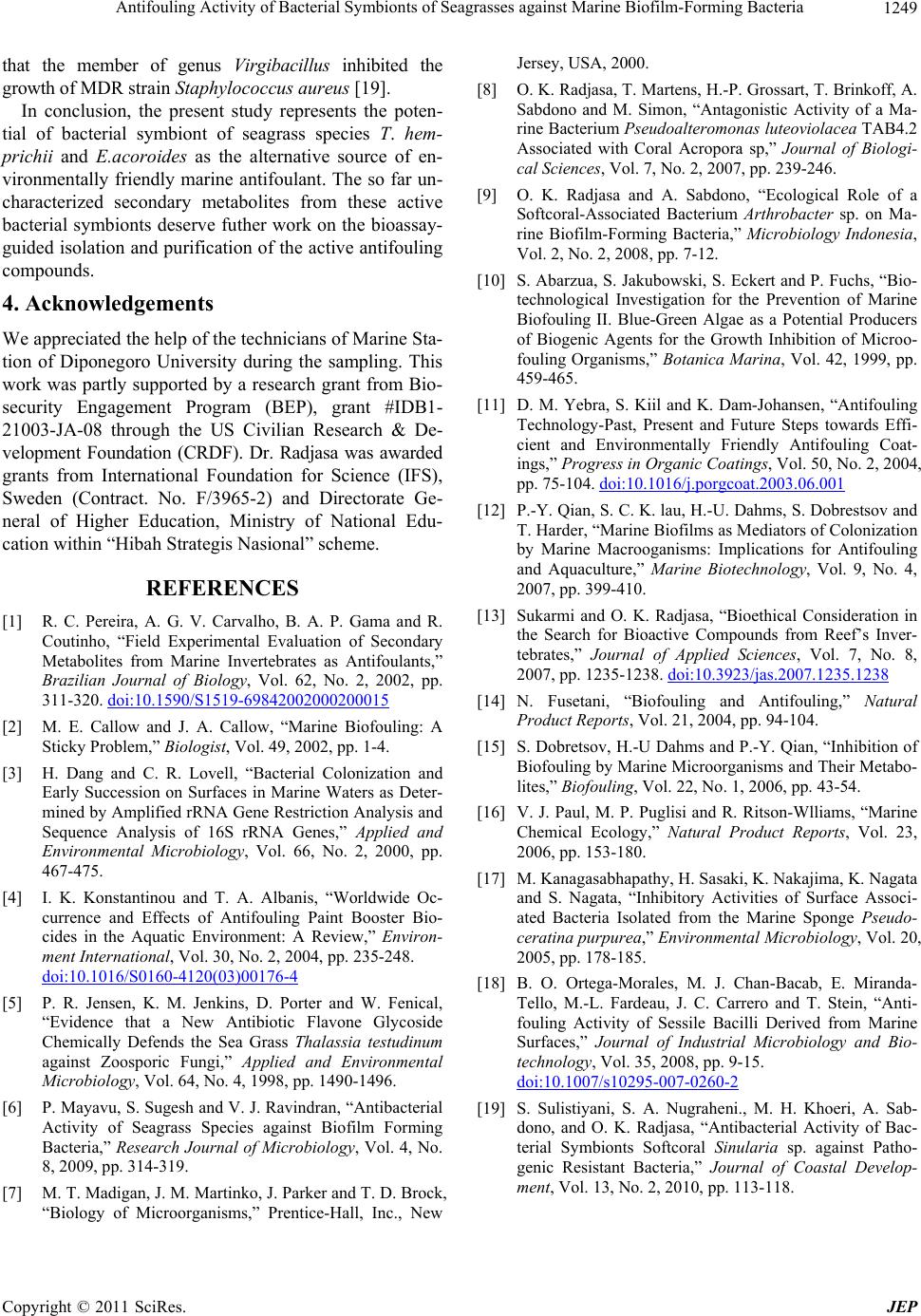
Antifouling Activity of Bacterial Symbionts of Seagrasses against Marine Biofilm-Forming Bacteria1249
that the member of genus Virgibacill us inhibited the
growth of MDR strain Staphylococcus aureus [19].
In conclusion, the present study represents the poten-
tial of bacterial symbiont of seagrass species T. hem-
prichii and E.acoroides as the alternative source of en-
vironmentally friendly marine antifoulant. The so far un-
characterized secondary metabolites from these active
bacterial symbionts deserve futher work on the bioassay-
guided isolation and purification of the active antifouling
compounds.
4. Acknowledgements
We appreciated the help of the technicians of Marine Sta-
tion of Diponegoro University during the sampling. This
work was partly supported by a research grant from Bio-
security Engagement Program (BEP), grant #IDB1-
21003-JA-08 through the US Civilian Research & De-
velopment Foundation (CRDF). Dr. Radjasa was awarded
grants from International Foundation for Science (IFS),
Sweden (Contract. No. F/3965-2) and Directorate Ge-
neral of Higher Education, Ministry of National Edu-
cation within “Hibah Strategis Nasional” scheme.
REFERENCES
[1] R. C. Pereira, A. G. V. Carvalho, B. A. P. Gama and R.
Coutinho, “Field Experimental Evaluation of Secondary
Metabolites from Marine Invertebrates as Antifoulants,”
Brazilian Journal of Biology, Vol. 62, No. 2, 2002, pp.
311-320. doi:10.1590/S1519-69842002000200015
[2] M. E. Callow and J. A. Callow, “Marine Biofouling: A
Sticky Problem,” Biologist, Vol. 49, 2002, pp. 1-4.
[3] H. Dang and C. R. Lovell, “Bacterial Colonization and
Early Succession on Surfaces in Marine Waters as Deter-
mined by Amplified rRNA Gene Restriction Analysis and
Sequence Analysis of 16S rRNA Genes,” Applied and
Environmental Microbiology, Vol. 66, No. 2, 2000, pp.
467-475.
[4] I. K. Konstantinou and T. A. Albanis, “Worldwide Oc-
currence and Effects of Antifouling Paint Booster Bio-
cides in the Aquatic Environment: A Review,” Environ-
ment International, Vol. 30, No. 2, 2004, pp. 235-248.
doi:10.1016/S0160-4120(03)00176-4
[5] P. R. Jensen, K. M. Jenkins, D. Porter and W. Fenical,
“Evidence that a New Antibiotic Flavone Glycoside
Chemically Defends the Sea Grass Thalassia testudinum
against Zoosporic Fungi,” Applied and Environmental
Microbiology, Vol. 64, No. 4, 1998, pp. 1490-1496.
[6] P. Mayavu, S. Sugesh and V. J. Ravindran, “Antibacterial
Activity of Seagrass Species against Biofilm Forming
Bacteria,” Research Journal of Microbiology, Vol. 4, No.
8, 2009, pp. 314-319.
[7] M. T. Madigan, J. M. Martinko, J. Parker and T. D. Brock,
“Biology of Microorganisms,” Prentice-Hall, Inc., New
Jersey, USA, 2000.
[8] O. K. Radjasa, T. Martens, H.-P. Grossart, T. Brinkoff, A.
Sabdono and M. Simon, “Antagonistic Activity of a Ma-
rine Bacterium Pseudoalteromonas luteoviolacea TAB4.2
Associated with Coral Acropora sp,” Journal of Biologi-
cal Sciences, Vol. 7, No. 2, 2007, pp. 239-246.
[9] O. K. Radjasa and A. Sabdono, “Ecological Role of a
Softcoral-Associated Bacterium Arthrobacter sp. on Ma-
rine Biofilm-Forming Bacteria,” Microbiology Indonesia,
Vol. 2, No. 2, 2008, pp. 7-12.
[10] S. Abarzua, S. Jakubowski, S. Eckert and P. Fuchs, “Bio-
technological Investigation for the Prevention of Marine
Biofouling II. Blue-Green Algae as a Potential Producers
of Biogenic Agents for the Growth Inhibition of Microo-
fouling Organisms,” Botanica Marina, Vol. 42, 1999, pp.
459-465.
[11] D. M. Yebra, S. Kiil and K. Dam-Johansen, “Antifouling
Technology-Past, Present and Future Steps towards Effi-
cient and Environmentally Friendly Antifouling Coat-
ings,” Progress in Organic Coatings, Vol. 50, No. 2, 2004,
pp. 75-104. doi:10.1016/j.porgcoat.2003.06.001
[12] P.-Y. Qian, S. C. K. lau, H. -U. Dahms, S. Dobrestsov and
T. Harder, “Marine Biofilms as Mediators of Colonization
by Marine Macrooganisms: Implications for Antifouling
and Aquaculture,” Marine Biotechnology, Vol. 9, No. 4,
2007, pp. 399-410.
[13] Sukarmi and O. K. Radjasa, “Bioethical Consideration in
the Search for Bioactive Compounds from Reef’s Inver-
tebrates,” Journal of Applied Sciences, Vol. 7, No. 8,
2007, pp. 1235-1238. doi:10.3923/jas.2007.1235.1238
[14] N. Fusetani, “Biofouling and Antifouling,” Natural
Product Reports, Vol. 21, 2004, pp. 94-104.
[15] S. Dobretsov, H.-U Dahms and P.-Y. Qian, “Inhibition of
Biofouling by Marine Microorganisms and Their Metabo-
lites,” Biofouling, Vol. 22, No. 1, 2006, pp. 43-54.
[16] V. J. Paul, M. P. Puglisi and R. Ritson-Wlliams, “Marine
Chemical Ecology,” Natural Product Reports, Vol. 23,
2006, pp. 153-180.
[17] M. Kanagasabhapathy, H. Sasaki, K. Nakajima, K. N agata
and S. Nagata, “Inhibitory Activities of Surface Associ-
ated Bacteria Isolated from the Marine Sponge Pseudo-
ceratina purpurea,” Environmental Microbiology, Vol. 20,
2005, pp. 178-185.
[18] B. O. Ortega-Morales, M. J. Chan-Bacab, E. Miranda-
Tello, M.-L. Fardeau, J. C. Carrero and T. Stein, “Anti-
fouling Activity of Sessile Bacilli Derived from Marine
Surfaces,” Journal of Industrial Microbiology and Bio-
technology, Vol. 35, 2008, pp. 9-15.
doi:10.1007/s10295-007-0260-2
[19] S. Sulistiyani, S. A. Nugraheni., M. H. Khoeri, A. Sab-
dono, and O. K. Radjasa, “Antibacterial Activity of Bac-
terial Symbionts Softcoral Sinularia sp. against Patho-
genic Resistant Bacteria,” Journal of Coastal Develop-
ment, Vol. 13, No. 2, 2010, pp. 113-118.
Copyright © 2011 SciRes. JEP